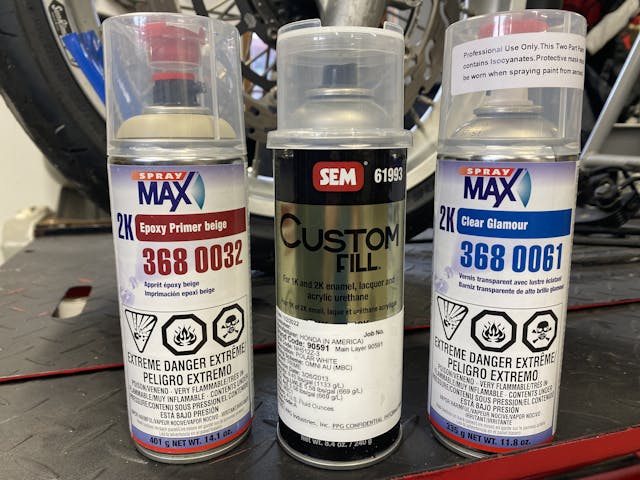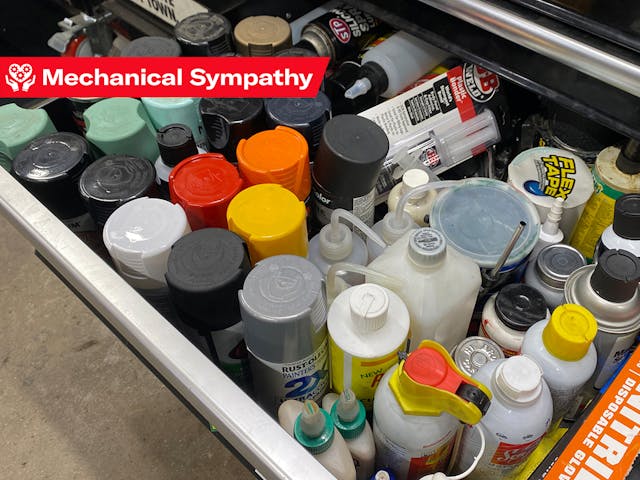Aerosol cans: The unsung hero of your garage
Almost every garage holds one thing that every DIY enthusiast thinks little about: an aerosol can. These nifty cylinders give us the superpower of a quick and easy solution for everything from pigment application to the accurate dispersal of lubrication.
To be frank, I’m not sure how a lot of garages would function without access to aerosol products. But where did they come from?
For all the convenience it now gives, the aerosol spray can was born in utility bordering on necessity. The technology was patented in 1927 by a Norwegian engineer searching for a faster way to wax his skis. Its first wide use, however, came in World War II. Of all the things that conspired to kill American service members in the South Pacific, mosquitoes—and the malaria they carried—proved the hardest to fight. To battle a brigade of flying bugs, the Army turned to a pressurized canister dispersing the pesticide DDT. When the war ended, the technology made its way to civilian life and many other uses.
Those early aerosol cans kept their propellants at high-pressure and were quite volatile. Refinements to the vessels and their delivery valves resulted in something that could safely be sold to consumers, but the transition to low-pressure propellants was critical in making mass adoption possible. The initial propellant solution was a family of chemical compounds called chlorofluorocarbons. Shorten that long word down and you get a three-letter acronym: CFCs. Those compounds offered safety and utility but unfortunately didn’t age well. The trouble lay in a chlorine that attacked the ozone layer and potentially contributed to climate change.
In 1978, CFCs left the cans found on consumer shelves. New government regulations mandated the change, pushing for a transition to liquified propellants more kind to the environment. Names like isobutane, butane, and pentane now push product from most modern aerosols.
Propellant is just one third of a recipe that the National Aerosol Association says makes an aerosol product:
- Active ingredients (soap or disinfectant, paint, cleaner, etc.)
- Inert or inactive ingredients (i.e., water or another filler)
- Propellant
Of course, there’s also the ball bearing that helps to mix the can’s ingredients. It gave us the common nickname: rattle can. And while the chemistry of those cans is complex, their use case is stunningly simple: That three-part formula enables home-game restorers and road-trip warriors to easily tackle a multitude of projects.
My garage now holds around three dozen aerosol cans. I’ve even defended spray cans in the comments under a previous article of mine that documented the painting a motorcycle frame. The crux of the disagreement was the idea that aerosol paints are not a lasting solution for frame paint. This is both true and false.
At one point, any cured paint sprayed from a shake can was relatively fragile and low-quality, at least compared to pigments applied with permanent, nondisposable spray equipment. Those days are over. It’s now possible to drop by your local automotive-paint supplier and have the person behind the counter not only mix up the exact color you need, but put that color into an aerosol can so you can apply it at home. While you’re there, you can pick up a two-part catalyzed clear coat identical to what a professional painter would spray from their DeVilbiss gun and expensive, purpose-built air compressor. On top of that, the nozzle can be trusted to give an even, and often adjustable, spray pattern, one worlds better than what was available even 20 years ago.

In short, the phrase “it was rattle-canned” should no longer carry a negative connotation. The final quality of cured aerosol paint often has just as much to do with an applicator’s prep work and skill as the chemicals in the coating itself. Non-catalyzed paint will always be less chemically resistant compared to a true two-part product with a hardener, but if you use it right, that diminished durability will be the only difference. Any orange peel or adhesion problems—or the lack thereof—will likely be rooted in technique.
Finally, there’s the beauty of those tidy little stabilized storage containers. My chemical drawer holds a can of silicone lubricant that I stole from my father long ago—it wears a vintage Sears price label, that’s how old it is. Yet not only does it still spray, the lube inside is still good.
The ability to store a variety of chemicals easily and safely for long-term periodic use makes the aerosol can the unsung hero of the garage. The idea that my ability to paint terrible flames on a motorcycle gas tank is rooted in soldiers trying not to die from mosquitoes? Both funny and humbling.
So many parts of our hobby have roots in odd places in history. But few have lived as long, and been as widely loved, as the aerosol. I’ll celebrate by raising the nearest one in a toast, then giving it a quick rattle and shake as salute. Seems appropriate, right?



Not a ball bearing, for mixing, but a marble!
At first, I thought Kyle had snuck into my garage and snapped a picture of one of my several stashes of aerosol cans. But then I realized that what I was seeing was far too organized-looking to be mine. I certainly agree that the quality of paint within spray cans has improved over the years, and have in fact seen great long-lasting results from relatively inexpensive products. To a much lesser degree the nozzles are better, but far from perfect. Careful must be taken to prevent clogs (I keep a small, lidded container of solvent on the bench and toss tips in it after each paint session).
I often use up the “dregs” of paint from several not-quite-used-up cans to coat small items on project with 1 or 2 coats over the primer before final coats of the desired color. I once even built a mini-bike and painted it 100% using up various colors of leftover stuff off the paint shelf.
I’ve seen videos on recharging aerosol cans that’ve bled off pressure, but still contain liquid, but have never had any luck with that. The ones I’ve had, I typically just carefully poke a hole in (after confirming the pressure is indeed depleted) and drained the product out into a container and applied using different methods.